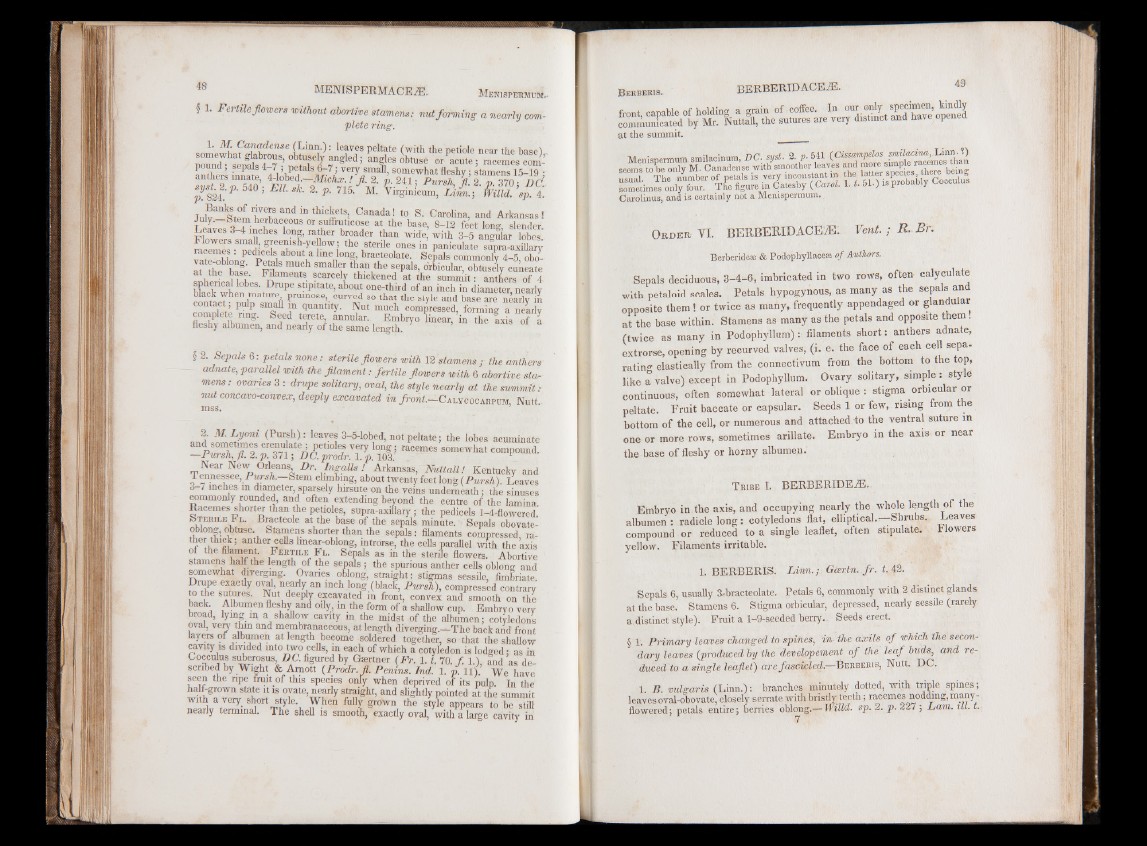
§ 1. Fertile flowers without abortive stamens: nut fa m in g a nearly complete
ring.
^{' Canadense (Linn.): leaves peltate (with, the petiole near the base)
or acute ; racemes com-’
pound, sepals 4-7 , petals 6-7 ; very small, somewhat fleshy : stamens 15-19 •
anthers mnate, 4-lobed.—Michx. ! fl. 2. v. 241 ■ Pursh fl T ™ n r
J u l v ^ t e m h lT and“ thic£ ets! Canada! to S. Carolina, and Arkansas!
July.—btem herbaceous or suffruticose at the base, 8-12 feet Ions slender
Leaves 3-4 inches long, rather broader than wide, with 3-5 anguiar lobes'
r ~ ^ Su e i ! r r V f ° Wf the sterile ones in paniculate supra-axillary
racemes . pedicels about a line long, bracteolate. Sepals commonlv 4-5 obom
theb W PW W UtCh SmaUf th,annthe sePals> at the base. Filaments scarcely thickened at thoer bsicuumlamr, ito b: tuasnetlhye rcsu noefa t4e
spherical lobes. Drupe stipitate, about one-third of an inch in diameter nearly
îciomntalTct , ?purlp astmUra^ll Pinru qmu0asnet>i. ty. Nut8 0m Much thcoem stpyrlees asendd, bfaosrem “ineg na enXear ilny
S f d ‘« été a n n u ls Embryo linear,’in thè lx îs of a
fleshy albumen, and nearly of the same length.
§2 Sepals 6 : petals none: sterile flowers with 12 stamens; the anthers
adnate, parallel with the filament : fertile flowers with 6 abortive star
mem : ovaries 3 : drupe solitary, oval, the style nearly at the summit :
nut concavo-convex, deeply excavated in front.—C alycocarpum N u tt,
mss.
2. M. Lyoni (Pursh): leaves 3-5-lobed, not peltate ; the lobes acuminate
and sometimes cremflate; petioles very long; racemes somewhat compound.
—Pursh, fl. 2.p. 371 ; DC. prodr. l.p . 103. ~ 1
Near New Orleans, Dr. Ingalls ! Arkansas, Nuttall! Kentucky and
Tennessee^Pitrsh. Stem climbing, about twenty feet long (Pursh). Leaves
3-7 inches m diameter, sparsely hirsute on the veins underneath : the sinuses
commonly rounded, and often extending beyond the centre of- the lamina.
Racemes shorter than the petioles, supra-axillary ; the pedicels 1-4-flowered.
S teeïle F 1.. Bracteole at the base of the sepals minute. Sepals obovate-
oblong, obtuse Stamens shorter than the sepals: filaments compressed, ra-
ther thick; anther cells linear-oblong, introrse, the cells parallel with the axis
of the lament. F ertile F l. Sepals as in the sterile flowers. Abortive
stamens half the length of the sepals ; the spurious anther cells oblong and
somewhat diverging. Ovanes oblong, straight: stigmas sessile, fimbriate.
Drupe exactly oval, nearly an inch long (black, Pursh), compressed contrary
to the sutures. Nut deeply excavated in front, convex and smooth on the
back. Albumen fleshy and oily, in the form of a shallow cup. Embryo very
broad, lying m a shallow cavity in the midst of the albumen; cotyledons
oval, very thm and membranaceous, at length diverging— The back and front
layers of albumen at length become soldered together, so that the shallow
cavity is divided into two cells, m each of which a cotyledon is lodged ; as in
Cocculus suberosus, DC. figured by Gærtner (Fr. 1. t. 70 f. 1 ) dnd as de
scribed by Wight & Arnott {Prodr. fl. Penins. Ind. 1. p. 11). We have
seen the npe fruit of this species only when deprived of its pulp. In the
half-grown state it is ovate, nearly straight, and slightly pointed at the summit
with a very short style. When fully grown the style appears to be still
nearly terminal. The shell is smooth, exactly oval, with a large cavity in
front caDable of holding a grain of coffee. In our only specimen, kindly
communicated by Mr. Nuttall, the sutures are very distinct and have open
at the summit.
Carolinus, and is-certainly not a Menispermum.,
O r d e r VI. BERBERIDACEAS. Vent. ; R . B f .
Berberidese & Podophyllacete of Authors..
Sepals deciduous, 3 -4 -6 , imbricated in two rows, often c a lcu la te
with petaloid scales. Petals hypogynous, as many as the sepals and
opposite them ! or twice as many, frequently appendaged or glandular
at the base within. Stamens as many as the petals and opposite them .
(twice as many in Podophyllum): filaments short: anthers adnate,
extrorse, opening by recurved valves, (i. e. the face o f each cell sepa-
rating elastically from the connectivum from the bottom to the top,
like a valve) except in Podophyllum. Ovary solitary, sim p le: style
continuous, often somewhat lateral or oblique : stigma orbicular or
peltate. Fruit baccate or capsular. Seeds 1 or few, rising from the
bottom o f the cell, or numerous and attached -to the ventral suture in
one or more rows, sometimes arillate. Embryo in the axis or near
the base o f fleshy or horny albumen.
T ribe I. BERBERIDE.^E.
Embryo in the axis, and occupying nearly the whole length o f the
albumen: radicle long: cotyledons flat, elliptical.— Shrubs. Leaves
compound or reduced to a single leaflet, often stipulate, blowers
yellow. Filaments irritable.
1. BERBERIS. Linn.; Gcer.tn. f r . t. 42.
Sepals 6, usually 3-bracteolate. Petals 6, commonly with 2 distinct glands
at the base. Stamens 6. Stigma orbicular, depressed, nearly sessile (rarely
a distinct style). Fruit a 1-9-seeded berry. Seeds erect.
§ 1. Primary leaves changed to spines, in the axils o f which the secondary
leaves (produced by the developement o f the leaf buds, and reduced
to a single leaflet) are fascicled— B erberis, Nutt. DC.
1. B. vulgaris (Linn.): branches minutely dotted, with triple spines;
leaves oval-obovate, closely serrate with bristly teeth; racemes nodding, many-
flowered; petals entire; berries oblong.— Willd. sp. 2. p. 227 ; Lam. ill. t.